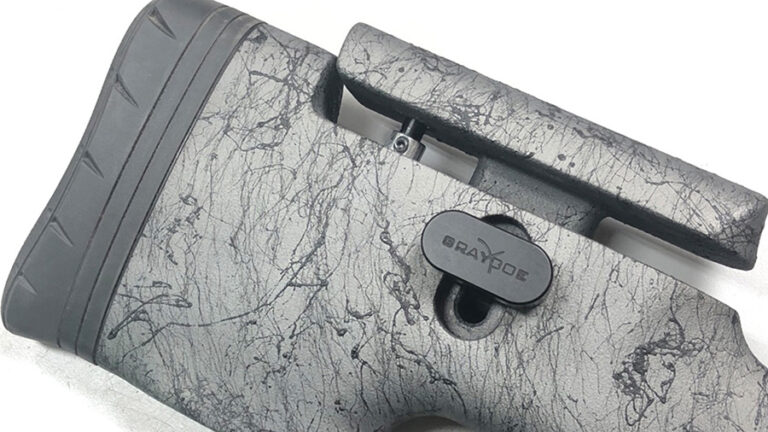TAG Precision—American-made RMR Plate for Kimber
For users of optics-ready Kimber 1911 and 2K11 pistols, TAG Precision has announced…
For users of optics-ready Kimber 1911 and 2K11 pistols, TAG Precision has announced…
Fountain Valley, CA—SureFire, LLC, manufacturer of the world’s finest—and most innovative—illumination tools and…
Shinenyx—creators of a cutting-edge fusion of digital night vision and thermal imaging technology—has…
All shooting is a balance between speed and precision. By that I mean you can…
The Mod-Navy Qual I’ve been doing this qual (or drill, or whatever the current nom…
• Built for road trips and off-road use• Manual transmission equipped• Wrapped in MultiCam Arctic…
Unlike Iraq, which has a fairly well-developed, modern highway and road system and accommodating terrain, Afghanistan can be a nightmare to move around. The central government has been working to complete a “ring road” which will generally circle the country and provide at least some access to the various provinces, but that’s only a first step. The country is rugged and remains mostly undeveloped.
For a modern military that relies on a complex logistics system to move tons of cargo to where it’s needed, the lack of a decent road system can present tremendous challenges—and that’s the case even when insurgents aren’t complicating the matter by planting IEDs along the routes. Consequently, the conflict in Afghanistan has seen a high level of reliance on aerial resupply. Sometimes that means helicopters, but those airframes are in short supply and needed for other duties as well, such as inserting combat troops and providing MEDEVACs. So some of that aerial resupply has arrived dangling at the end of a parachute.
That’s where the Sherpa PADS comes in. Its manufacturer, MMIST, will be exhibiting at this year’s Eurosatory defense and security exhibition in Paris.
The PADS, or Precision Aerial Delivery System, is essentially a GPS-guided parachute system designed to put cargo airdrops right where the loadmaster wants them. Deliverable from both rotary-wing and fixed-wing aircraft, the PADS eliminates a number of problems and hazards inherent in aerial cargo delivery.
Without any sort of steering capability, the only way to get cargo on the ground at least reasonably close to the troops you’re trying to resupply is to drop from as low an altitude as possible and at a fairly low speed. (There’s a reason paratroopers jump from only 1,250 feet.) In hostile territory, the problem with flying “slow and low” in a lumbering cargo aircraft is that the delivery bird presents a big, fat target for MANPADS (shoulder-launched antiaircraft missiles), medium-caliber weapons like the 12.7mm machine gun, and even small arms. PADS gets around that problem by allowing drops from much higher altitudes, outside the engagement envelope of guns and even MANPADS missiles.
Precisely-controlled drops also eliminate such issues as troops having to venture far away from their outpost to retrieve cargo—placing them at risk of ambush or engagement by enemy forces—or, in such brutal terrain as Afghanistan offers, having an airdrop wind up scattered across a rocky mountaintop or vanished into a ravine.
Sherpa, which in its “Ranger” military variant can handle cargo pallets of 100 to 1,200 pounds, offers both HALO (high altitude, low opening) and HAHO (high altitude, high opening) delivery options. It uses a ram-air parafoil instead of a traditional parachute, providing steering capability that can even overcome high winds. In fact, both Sherpa variants (the Ranger and the Provider) have circular error probabilities of less than 100 meters, meaning the pallet will land within a 100 meter radius of its target. Another handy feature is the remote control option, which provides the ability to redirect the PADS to a new target in mid-flight.
MMIST has created a highly capable, reusable system for putting cargo airdrops exactly where they need to be while keeping both aircrews and troops on the ground as safe as possible. Sherpa has proved highly effective in Afghanistan, and there is no way to know how many lives have been saved by replacing resupply convoys along dangerous routes with airdrops.
You can visit MMIST in Hall 5 at Eurosatory 2012.
Guns & Tactics is an online media outlet that focuses on the firearms community, not just firearms and gear but also quality training, technical break downs and enlightening presentations.
[dcs_img_right framed=”black” w=”165″ h=”115″] http://gunsandtactics.wpengine.com/wp-content/uploads/2012/03/konuslogo.jpg [/dcs_img_right] Konus Optical & Sports System joins the social networking community with the launch of its Facebook page where fans will be able…
Fairfax, Va. –- (gunsandtactics.com) — The NRA National Action Pistol Championship, also known as the MidwayUSA & NRA Bianchi Cup, returns to Green Valley Rifle & Pistol Club…
I recently traveled to Bend, Oregon to compete at the Crimson Trace Midnight 3-Gun Invitational and report on the event for Guns & Tactics Magazine. It’s the only match of its kind, taking place on the Oregon high desert with competitors shooting in the dark of night into early morning using lights and lasers. It was an amazing experience and my first 3-gun match, ever.
Manufacturer provides shooters the opportunity to train virtually anywhere Ferndale, WA (gunsandtactics.com) – NextLevel Training (NLT), manufacturer of firearms training products, has revolutionized the way shooters prepare with…

ZeroTech Optics unveils the Thrive HD binocular series featuring industry leading ED glass boasting both durability and optical performance.

If you have a rifle with an adjustable cheek rest or cheek piece and want that rest to return to the same spot every time, well this video is for you.
© 2026 UN12 Magazine
© 2026 UN12 Magazine
Wait! Don’t forget to